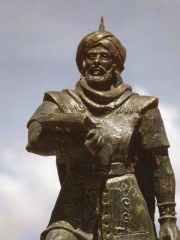




The Most Famous
MILITARY PERSONNELS from Saudi Arabia
This page contains a list of the greatest Saudi Arabian Military Personnels. The pantheon dataset contains 1,468 Military Personnels, 6 of which were born in Saudi Arabia. This makes Saudi Arabia the birth place of the 33rd most number of Military Personnels behind Estonia and Azerbaijan.
Top 6
The following people are considered by Pantheon to be the most legendary Saudi Arabian Military Personnels of all time. This list of famous Saudi Arabian Military Personnels is sorted by HPI (Historical Popularity Index), a metric that aggregates information on a biography’s online popularity.

1. Khalid ibn al-Walid (592 - 642)
With an HPI of 77.80, Khalid ibn al-Walid is the most famous Saudi Arabian Military Personnel. His biography has been translated into 61 different languages on wikipedia.
Khalid ibn al-Walid ibn al-Mughira al-Makhzumi (Arabic: خالد بن الوليد بن المغيرة المخزومي, romanized: Khālid ibn al-Walīd ibn al-Mughīra al-Makhzūmī; died 642) was a 7th-century Arab military commander. He initially headed campaigns against Muhammad on behalf of the Quraysh. He later became a Muslim and spent the remainder of his career in service to Muhammad and the first two Rashidun caliphs: Abu Bakr and Umar. Khalid played the leading command roles in the Ridda Wars against rebel tribes in Arabia in 632–633, the initial campaigns in Sasanian Iraq in 633–634, and the conquest of Byzantine Syria in 634–638. As a horseman of the Quraysh's aristocratic Banu Makhzum clan, which ardently opposed Muhammad, Khalid played an instrumental role in defeating Muhammad and his followers during the Battle of Uhud in 625. In 627 or 629, he converted to Islam in the presence of Muhammad, who inducted him as an official military commander among the Muslims and gave him the title of Sayf Allah (lit. 'Sword of God'). During the Battle of Mu'ta, Khalid coordinated the safe withdrawal of Muslim troops against the Byzantines. He also led the Bedouins under the Muslim army during the Muslim conquest of Mecca in 629–630 and the Battle of Hunayn in 630. After Muhammad's death, Khalid was appointed to Najd and al-Yamama with the purpose of suppressing or subjugating Arab tribes who were opposed to the nascent Muslim state; this campaign culminated in Khalid's victory over Arab rebel leaders Tulayha and Musaylima at the Battle of Buzakha in 632 and the Battle of Yamama in 633, respectively. Khalid subsequently moved against the largely Christian Arab tribes and the Sasanian Persian garrisons of the Euphrates valley in Iraq. He was reassigned by Abu Bakr to command the Muslim armies in Syria and he led his men there on an unconventional march across a long, waterless stretch of the Syrian Desert, boosting his reputation as a military strategist. As a result of decisive victories led by Khalid against the Byzantines at Ajnadayn (634), Fahl (634 or 635), Damascus (634–635), and the Yarmouk (636), the Rashidun army conquered most of the Levant. Khalid was subsequently demoted and removed from the army's high command by Umar. Khalid continued service as the key lieutenant of his successor Abu Ubayda ibn al-Jarrah in the sieges of Homs and Aleppo and the Battle of Qinnasrin, all in 637–638. These engagements collectively precipitated the retreat of imperial Byzantine troops from Syria under Emperor Heraclius. Umar then dismissed Khalid from the governorship of Jund Qinnasrin around 638. Khalid died in either Medina or Homs in 642. He is generally considered by historians to be one of the most seasoned and accomplished generals of the early Islamic era, and he is likewise commemorated throughout the Arab world. Islamic tradition credits Khalid for his battlefield tactics and effective leadership of the early Muslim conquests, but also accuses him of illicitly executing Arab tribesmen who had accepted Islam—namely members of the Banu Jadhima during the lifetime of Muhammad, and Malik ibn Nuwayra during the Ridda Wars—and being responsible for moral and fiscal misconduct in the Levant. Khalid's military fame disturbed some of the pious early Muslims, most notably Umar, who feared it could develop into a personality cult.

2. Sa'd ibn Abi Waqqas (595 - 674)
With an HPI of 69.64, Sa'd ibn Abi Waqqas is the 2nd most famous Saudi Arabian Military Personnel. His biography has been translated into 39 different languages.
Sa'd ibn Abi Waqqas ibn Wuhayb al-Zuhri (Arabic: سَعْد بْنِ أَبِي وَقَّاص بْنِ وهَيْب الزُّهري, romanized: Saʿd ibn Abī Waqqāṣ ibn Wuhayb al-Zuhrī) was an Arab Muslim commander. He was the founder of Kufa and served as its governor under Umar ibn al-Khattab. He played a leading role in the Muslim conquest of Persia and was a close companion of the Islamic prophet Muhammad. Sa'd was the seventh free adult man to embrace Islam, which he did at the age of seventeen. Sa'd participated in all battles under Muhammad during their stay in Medina. Sa'd was famous for his leadership in the Battle of al-Qadisiyyah and the conquest of the Sasanian capital Ctesiphon in 636. After the Battle of al-Qadisiyyah and the Siege of Ctesiphon (637), Sa'd served as the supreme commander of the Rashidun army in Iraq, which conquered Khuzestan and built the garrison city of Kufa. Due to complaints about his conduct, he was later dismissed from his post by the caliph Umar. During the First Fitna, Sa'd was known for leading the neutral faction that contained the majority of the companions of Muhammad and their followers, who refused to be involved in the civil war. Traditions of Chinese Muslims hold that he introduced Islam to China during a diplomatic visit in 651, though these accounts are disputed. Sunni historians and scholars regard Sa'd as an honored figure due to his companionship with Muhammad, his inclusion as one of the ten to whom Paradise was promised, and his participation in the Battle of Badr, whose participants are collectively held in high esteem.

3. Abraha (600 - 600)
With an HPI of 67.39, Abraha is the 3rd most famous Saudi Arabian Military Personnel. His biography has been translated into 28 different languages.
Abraha (Ge’ez: አብርሃ) (also spelled Abreha, died presumably in 570 CE), also known as Abraha al-Ashram (Arabic: أَبْرَهَة ٱلْأَشْرَم), was a viceroy for the Kingdom of Aksum who ruled the Himyarite Kingdom of Yemen and much of the Arabian Peninsula in the 6th century. He is famous for the tradition of his attempt to destroy the Kaaba, a revered religious site in Mecca, using an army that included war elephants, an event known as Year of the Elephant. During his reign, Christianity was the most populous of all.

4. Amr ibn al-As (580 - 664)
With an HPI of 66.50, Amr ibn al-As is the 4th most famous Saudi Arabian Military Personnel. His biography has been translated into 40 different languages.
Amr ibn al-As ibn Wa'il al-Sahmi (Arabic: عَمْرِو بْنِ الْعَاصِ بْنِ وَائِل السَّهْمِي, romanized: ʿAmr ibn al-ʿĀṣ ibn Wāʾil al-Sahmī; c. 573 – 664) was the Arab commander who led the Muslim conquest of Egypt and served as its governor in 640–646 and 658–664. The son of a wealthy Qurayshite, Amr embraced Islam in c. 629 and was assigned important roles in the nascent Muslim community by the Islamic prophet Muhammad. The first caliph Abu Bakr (r. 632–634) appointed Amr as a commander of the conquest of Syria. He conquered most of Palestine, to which he was appointed governor, and helped lead the Arabs to decisive victories over the Byzantines at the battles of Ajnadayn and the Yarmuk in 634 and 636. Amr launched the conquest of Egypt on his own initiative in late 639, defeating the Byzantines in a string of victories ending with the surrender of Alexandria in 641 or 642. It was the swiftest of the early Muslim conquests. This was followed by westward advances by Amr as far as Tripoli in present-day Libya. In a treaty signed with the Byzantine governor Cyrus, Amr guaranteed the security of Egypt's population and imposed a poll tax on non-Muslim adult males. He maintained the Coptic-dominated bureaucracy and cordial ties with the Coptic patriarch Benjamin. He founded Fustat as the provincial capital with the mosque later called after him at its center. Amr ruled relatively independently, acquired significant wealth, and upheld the interests of the Arab conquerors who formed Fustat's garrison in relation to the central authorities in Medina. After gradually diluting Amr's authority, Caliph Uthman (r. 644–656) dismissed him in 646 after accusations of incompetency from his successor Abd Allah ibn Sa'd. After mutineers from Egypt assassinated Uthman, Amr distanced himself from their cause, despite previously instigating opposition against Uthman. In the ensuing First Fitna, Amr joined Mu'awiya ibn Abi Sufyan against Caliph Ali (r. 656–661) due to promises of the governorship of Egypt and its tax revenues. Amr served as Mu'awiya's representative in the abortive arbitration talks to end the war. Afterward, he wrested control of Egypt from Ali's loyalists, killing its governor Muhammad ibn Abi Bakr, and assumed the governorship instead. Mu'awiya kept him in his post after establishing the Umayyad Caliphate in 661 and Amr ruled the province until his death.

5. Muhammad bin Qasim (695 - 715)
With an HPI of 65.08, Muhammad bin Qasim is the 5th most famous Saudi Arabian Military Personnel. His biography has been translated into 34 different languages.
Muḥammad ibn al-Qāsim al-Thaqafī (Arabic: محمد بن القاسم الثقفي; (695-12-31)31 December 695–(715-07-18)18 July 715) was an Arab military commander in service of the Umayyad Caliphate who led the Muslim conquest of Sindh (and Punjab, part of ancient Sindh), inaugurating the Umayyad campaigns in India. His military exploits led to the establishment of the Islamic province of Sindh, and the takeover of the region from the Sindhi Brahman dynasty and its ruler, Raja Dahir, who was subsequently decapitated with his head sent to al-Hajjaj ibn Yusuf in Basra. With the capture of the then-capital of Aror by Arab forces, Muhammad ibn al-Qasim became the first Muslim to have successfully captured Indian land, which marked the beginning of Muslim rule in South Asia. Muhammad ibn al-Qasim belonged to the Banu Thaqif, an Arab tribe that is concentrated around the city of Taif in western Arabia. After the Muslim conquest of Persia, he was assigned as the governor of Fars, likely succeeding his uncle Muhammad ibn Yusuf al-Thaqafi. From 708 to 711, Muhammad ibn al-Qasim led the Sindh conquest. He established Islamic rule throughout the region, serving as governor of Sindh from 712 until his death in 715. After his last conquest of Multan (Punjab) he returned to Arabia where on the way he died in Mosul, in modern Iraq, though some sources record that his body was buried in Makran, a semi-desert coastal region in Balochistan.

6. Uqba ibn Nafi (622 - 683)
With an HPI of 60.98, Uqba ibn Nafi is the 6th most famous Saudi Arabian Military Personnel. His biography has been translated into 26 different languages.
ʿUqba ibn Nāfiʿ ibn ʿAbd al-Qays al-Fihrī al-Qurashī (Arabic: عقبة بن نافع بن عبد القيس الفهري القرشي, romanized: ʿUqba ibn Nāfiʿ ibn ʿAbd al-Qays al-Fihrī), also simply known as Uqba ibn Nafi, was an Arab general serving the Rashidun Caliphate since the reign of Umar and later the Umayyad Caliphate during the reigns of Mu'awiya I and Yazid I, leading the Muslim conquest of the Maghreb, including present-day Libya, Tunisia, Algeria and Morocco. He is credited with establishing Umayyad rule in North Africa. Uqba was the nephew of Amr ibn al-As. He is often surnamed al-Fihri in reference to the Banu Fihr, a clan connected to the Quraysh. His descendants would be known as the ʿUqbids or Fihrids.
Pantheon has 6 people classified as military personnels born between 580 and 695. Of these 6, none of them are still alive today. The most famous deceased military personnels include Khalid ibn al-Walid, Sa'd ibn Abi Waqqas, and Abraha.
Deceased Military Personnels
Go to all Rankings
Khalid ibn al-Walid
592 - 642
HPI: 77.80
Sa'd ibn Abi Waqqas
595 - 674
HPI: 69.64
Abraha
600 - 600
HPI: 67.39
Amr ibn al-As
580 - 664
HPI: 66.50
Muhammad bin Qasim
695 - 715
HPI: 65.08
Uqba ibn Nafi
622 - 683
HPI: 60.98






